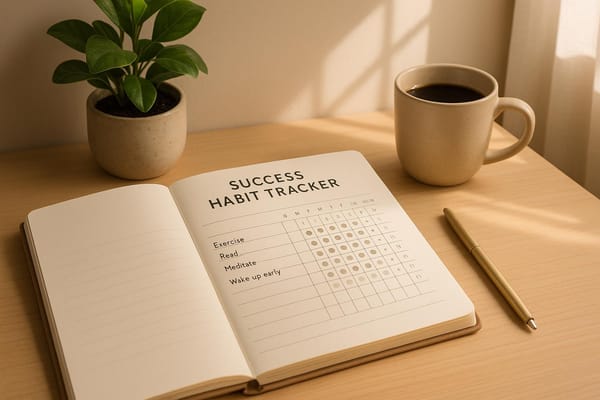7 Daily Habits That Build Mental Strength
Explore seven daily habits that enhance mental strength, boost resilience, and help you navigate life's challenges with confidence.

Building mental strength doesn’t require special talents or resources - it’s about consistent habits. Here are seven practices to strengthen your mindset and handle challenges effectively:
- Mindfulness: Spend 5–10 minutes daily focusing on the present. Techniques like meditation, deep breathing, or mindful walking can reduce stress and improve focus.
- Journaling: Write down your thoughts and emotions to process them better. Use prompts like, “What made me proud today?” or “What did I learn from a challenge?”
- Positive Self-Talk: Replace negative thoughts with affirmations like, “I can handle this.” Pair this with self-compassion to treat yourself kindly during setbacks.
- Physical Activity: Regular movement, even a 20-minute walk, boosts mood, reduces stress, and sharpens focus.
- Accept Discomfort: Push beyond your comfort zone with small challenges, like trying new activities or reframing failures as learning opportunities.
- Stress Management: Identify triggers, set boundaries, and practice relaxation techniques like yoga or breathing exercises.
- Social Connections: Strengthen relationships by spending quality time with loved ones or joining groups that align with your interests.
Start small by picking one habit to focus on, and gradually build from there. These habits not only help you handle stress but also create a more balanced, resilient mindset over time.
10 Daily Habits To Become Mentally Strong
1. Practice Daily Mindfulness
Mindfulness acts as a mental reset, helping you focus on the present without judgment or distraction. Instead of stressing over tomorrow’s meeting or replaying yesterday’s mistakes, it trains your mind to stay anchored in the now.
What’s great about mindfulness is how straightforward it is. You don’t need fancy tools, pricey apps, or blocks of free time to get started. Even a few moments of focused attention can significantly impact how you manage stress and strengthen your mental resilience. For example, participants in an 8-week mind-body program practiced mindfulness for just 10–15 minutes daily, showing that consistency matters far more than long sessions.
Dr. James E. Stahl from Dartmouth-Hitchcock Medical Center underscores this point: "Consistency is key". Practicing mindfulness for just 5 minutes every day can be far more effective than cramming an hour-long session into your week.
Meditation and Deep Breathing
Meditation and deep breathing are natural extensions of mindfulness. They help anchor your attention and calm your mind. Start with something as simple as focusing on your breath - it’s always with you and requires no preparation. Find a quiet spot where you can sit comfortably without interruptions. This could be your bedroom, a cozy corner of your living room, or even your car during a lunch break.
Close your eyes gently and tune into your natural breathing rhythm. Pay attention to how your chest rises and falls or the sensation of air moving in and out of your nostrils. If your mind starts to wander, don’t get frustrated - just notice the thoughts and gently guide your focus back to your breath.
Research from Harvard Health highlights how observing your breath can reduce stress and pave the way for a healthier, more mindful life. Dr. Ronald D. Siegel from Harvard Medical School explains: "Learning to focus attention and relax is a skill. Like any skill, it gets better with practice".
For quick stress relief, try the 4-7-8 technique: inhale for 4 seconds, hold your breath for 7 seconds, and exhale slowly for 8 seconds. This simple breathing pattern activates your body’s relaxation response and can be done anywhere - whether you’re at your desk, stuck in traffic, or preparing for a tough conversation.
Start small with just 5 minutes of practice and gradually extend your sessions. Building a routine - whether it’s right after waking up, during your lunch break, or before bed - helps make mindfulness a daily habit. Over time, this practice builds the mental resilience needed to tackle life’s challenges.
If sitting meditation doesn’t feel right for you, mindful walking offers a more active way to stay present.
Mindful Walking
Turn your everyday walks into mindfulness exercises. Whether you’re strolling through your neighborhood, walking in a park, or pacing at work, you can use movement to stay grounded in the present.
Focus on the sensation of your feet touching the ground. Feel how your weight shifts from heel to toe with each step. Notice your breathing rhythm and the sounds around you. Do you hear birds chirping? Distant traffic? What does the air feel like on your skin? This heightened awareness pulls you out of autopilot and into the moment.
Even routine movements can become opportunities for mindfulness. A walk from your car to the office, climbing a flight of stairs, or even heading to the kitchen can serve as moments to center yourself.
Whether your goal is to reduce stress, sharpen your focus, or feel more connected to your environment, having a clear purpose makes mindfulness more meaningful.
2. Start Daily Journaling
Journaling offers a powerful way to deepen your self-awareness. By putting your thoughts and feelings into words, you give your mind a chance to process emotions, recognize patterns, and gradually build resilience. Think of it as a mental workout - one that strengthens your emotional and psychological well-being over time.
An expert puts it this way:
"Journaling is simply writing down your thoughts and feelings to understand them more clearly. And if you struggle with stress, depression, or anxiety, keeping a journal can be a great idea. It can help you gain control of your emotions and improve your mental health."
You don’t need fancy tools or perfect grammar - just a willingness to write. Research even suggests that journaling about your deepest thoughts can reduce the number of sick days you take.
Start small by setting aside a few minutes each day. Whether you prefer a traditional notebook or a digital app, the key is to let your thoughts flow freely. This isn’t about creating polished prose; it’s about carving out a safe space for your reflections.
Dr. Dan Siegel highlights the benefits of this practice:
"Writing in a journal activates the narrator function of our minds. Studies have suggested that simply writing down our account of a challenging experience can lower physiological reactivity and increase our sense of well-being, even if we never show what we've written to anyone else."
Journal for Emotional Awareness
Using your journal to explore your emotions can help you identify triggers, understand your reactions, and develop healthier coping mechanisms. By putting a bit of distance between yourself and overwhelming emotions, you gain clarity and control. Start by simply expressing how you feel, and then look for recurring themes or patterns.
Here are some prompts to guide your emotional exploration [20,21]:
- Think of a time when you felt proud of yourself. Write about the emotions you experienced and why they were so impactful.
- Recall a situation that made you anxious or nervous. Reflect on how you handled it and what you learned.
- Describe a moment when you felt angry or frustrated. Identify what triggered those feelings and how you managed them.
- Paint a picture of your current emotion as if it were a place - what does it look, sound, and feel like?
- Write a letter to the emotion you’re experiencing - whether it’s anger, sadness, joy, or confusion - and explore its underlying message.
- When a strong emotion arises, use the "five whys" technique by repeatedly asking "why?" to uncover its deeper layers.
Once you’ve gained insight into your emotions, you can use your journal to shift from reflection to action by setting clear goals for your day.
Set Daily Intentions
Your journal can be a powerful tool for turning scattered thoughts into focused action. Start your morning by asking yourself, "What does my ideal day look like today?" Picture everything from positive interactions to completing tasks with ease. This kind of visualization helps set the tone for a productive day.
Take a moment to rate your energy on a scale from 1 to 10. If your energy feels low, jot down a few ideas to lift your mood. You might find inspiration in an affirmation, a meaningful quote, or even a favorite song lyric - something that resonates with you and can guide your actions.
For longer-term growth, ask yourself: "What’s one thing I deeply want, and what small step can I take tomorrow to move closer to it?" At the end of the day, reflect on your actions. Think about the values you upheld and how you handled any challenges. This habit helps turn setbacks into lessons.
A simple structure for intention-setting might look like this: "Today, I am going to focus on… and success will look like…". This approach keeps your goals clear and helps you celebrate your achievements.
To make journaling a consistent habit, set aside about 30 minutes - 20 minutes for writing and 10 minutes for reflecting. Studies suggest that journaling for more than 30 days can amplify its benefits, especially for managing anxiety.
Therese Sheedy, a psychologist with Smiling Mind, explains the deeper value of journaling:
"I think the reason we turn to journaling is to try and find answers that are already there. We don't know that we have the power within, to heal ourselves. But, when we start to journal, we realise we do."
3. Use Positive Affirmations and Self-Compassion
One of the most impactful habits you can develop for mental resilience is refining your inner dialogue. The way you talk to yourself plays a huge role in shaping your mental strength. By replacing harsh self-criticism with positive affirmations and self-compassion, you're essentially training your brain to handle life's challenges with more ease. Research from Social Cognitive and Affective Neuroscience shows that self-affirmation activates parts of the brain associated with self-processing. Even better, regular use of affirmations can reduce stress and improve academic performance by changing how the brain reacts to threats.
Self-compassion complements affirmations beautifully in building emotional resilience. Studies have found that people who practice self-compassion experience less anxiety and depression. In fact, a randomized trial revealed that self-compassion significantly boosts mental health and overall life satisfaction. Making these practices part of your daily routine can transform how you face stress and setbacks, starting with creating personal affirmations.
Create Personal Affirmations
Not all affirmations are created equal. The most effective ones are personal, specific, and meaningful to your situation. Start by identifying the negative thoughts or beliefs that hold you back, then rewrite them in a positive way.
Focus on a specific area of your life where you'd like to see improvement. For example, if you're struggling with confidence at work or navigating a tough relationship, think about a realistic outcome that would make a difference for you. Use "I am" statements to craft affirmations that feel empowering and give you a sense of ownership.
Carinne Leduc shares her approach:
"The most impactful affirmations for me have been those that are personal and tailored to my specific situation. One of my favorites is, 'I am worthy of success.'" – Carinne Leduc
Keep your affirmations positive and written in the present tense. Instead of saying, "I will stop being anxious", try, "I am calm and capable of handling whatever comes my way." Frame them as if they are already true, and make them short and easy to remember.
If affirmations feel too far-fetched, start with a neutral tone. For instance, instead of jumping from "I'm terrible at this" to "I'm amazing at this", you could say, "I'm learning and improving every day." Think about what you'd say to a friend in a similar situation - it’s often easier to be kind to others than to ourselves.
JuneB describes her experience:
"Using affirmations like 'I believe in myself' has been a daily practice for me. It set the tone for my day and turned any negativity into a positive feeling." – JuneB
Consistency is key. Repeat your affirmations daily - morning and night. Write them in a journal, stick notes on your mirror, or set reminders on your phone. After about a month, check in with yourself to see how it’s going and adjust if needed.
Carinne Leduc offers this advice:
"Begin by selecting affirmations that truly resonate with your goals and values. Dedicate a few minutes each morning or evening to repeating them aloud, silently, or writing them down." – Carinne Leduc
Pair these affirmations with self-compassion to build an even stronger inner dialogue.
Practice Self-Compassion
Self-compassion means treating yourself with the same kindness, understanding, and patience that you would offer a friend - especially during tough times. It involves three elements: self-kindness, recognizing shared humanity, and mindfulness. This practice isn’t just about feeling good; it’s about building long-term emotional well-being.
Kristin Neff explains:
"Self-compassion is a practice of goodwill, not good feelings… With self-compassion we mindfully accept that the moment is painful, and embrace ourselves with kindness and care in response, remembering that imperfection is part of the shared human experience." – Kristin Neff
Start by treating yourself like you would a close friend. When you make a mistake or face a setback, ask yourself, "What would I say to a friend in this situation?" Extend that same understanding to yourself.
Recognize that mistakes are part of being human. Everyone experiences failure and difficult moments - it’s a shared experience. Be mindful of your inner dialogue. When you catch yourself thinking, "I’m so stupid for making that mistake", pause and reframe it as, "I made a mistake, and that’s part of learning. I’ll do better next time."
When things don’t go as planned, choose compassion over criticism. Acknowledge your feelings and remind yourself, "This is hard right now, and it’s okay to feel frustrated. I’m doing my best."
Self-soothing is also part of self-compassion. Comfort yourself physically and emotionally - whether that’s taking a warm bath, giving yourself a hug, or simply speaking to yourself in a gentler tone.
The goal isn’t to erase negative thoughts completely - that’s unrealistic. Instead, it’s about learning to accept your struggles without harsh judgment. This approach helps you develop a balanced view of yourself, one that acknowledges both strengths and weaknesses without tying your self-worth to external achievements.
Start small. When self-critical thoughts arise, pause and ask yourself, "How can I be kinder to myself in this moment?"
4. Stay Physically Active
Pairing physical activity with mindfulness and journaling is a fantastic way to build mental resilience. While mindfulness calms your mind and journaling helps untangle your thoughts, regular movement strengthens your ability to handle stress and stay clear-headed.
Exercise isn’t just about toning muscles or shedding pounds - it’s one of the best ways to boost your mental well-being. It changes your brain chemistry, reducing stress and sharpening focus. Research shows regular exercise can lower the risk of certain chronic illnesses by 20%-30%, but its impact on mental health is just as compelling.
The biological link between exercise and mental strength is fascinating. Athletic Republic North Dallas explains it well:
"When we exercise, our bodies release endorphins, neurotransmitters that act as natural stress relievers."
In addition to endorphins, physical activity lowers cortisol (the stress hormone) and increases serotonin and dopamine, which help regulate mood and happiness. Over time, regular exercise also fine-tunes your body’s stress response, making it easier to manage tough situations.
Beyond stress relief, exercise improves cognitive functions. It increases blood flow to the brain, delivering oxygen and nutrients that enhance memory, focus, and problem-solving. It also promotes better sleep, which in turn supports mental clarity and emotional balance. Even small fitness achievements can boost confidence, reinforcing your mental resilience in other areas of life.
Daily Movement for Mental Clarity
You don’t need to hit the gym for hours or train for a marathon to enjoy these benefits. Even small, consistent efforts can make a difference. According to the American Heart Association, adding just five minutes of exercise to your day can help manage stress and lower blood pressure.
Simple activities like a 20-minute walk or a quick yoga session can clear mental fog and reduce stress. Taking a walk during your lunch break or scheduling walking meetings are easy ways to incorporate movement into your day. Yoga, which blends physical activity with mindfulness, is especially effective for mental strength. You can even try mindful walking - focusing on your steps and breathing - to turn it into a meditative practice.
Strength exercises like push-ups, squats, or bodyweight routines are another great option. These can be done almost anywhere and improve both circulation and mental clarity. If you’re short on time, break your workout into smaller sessions throughout the day. For example, do squats while waiting for your coffee to brew or use commercial breaks for stretches and light exercises. Even taking the stairs instead of the elevator adds up.
Everyday activities like housework, gardening, or decorating count as movement too. Andy Gallardo, Director of Employee Wellness at Kaiser Permanente, highlights the importance of functional fitness:
"From crouching down in the garden to reaching high while shopping for groceries, you move in all sorts of ways every day. Functional fitness helps you stay strong and flexible as you go about your life."
Exercises that challenge balance and coordination, like standing on one foot or walking heel-to-toe, also improve physical stability and mental focus.
Make Exercise Consistent
The key to reaping the mental benefits of exercise is consistency, not intensity. Building a habit that sticks requires planning and realistic expectations. Alecia Gende, D.O., a Sports Medicine specialist, emphasizes:
"It is crucial to find a workout and nutrition plan you enjoy and can continue long term."
Treat your workouts like any other important appointment. Plan your exercise schedule at the start of the week and set reminders to stay on track.
Start small and build gradually. If you’re just starting out, aim for 10–15 minutes of movement rather than an hour-long session. Consistency matters more than duration, as noted by the Better Health Channel:
"Being active each day is one of the most important things you can do for your health."
Choose activities you enjoy. Exercise shouldn’t feel like a chore. Try different options - dancing, hiking, swimming, martial arts, or team sports - until you find something that feels fun.
Create accountability. Work out with a buddy, join a fitness group, or share your exercise goals with friends or family. Having someone to check in with can keep you motivated.
Remove obstacles. Lay out your workout clothes the night before or keep them handy for quick access. If you’re exercising at home, make sure your equipment is easy to reach.
Track progress and celebrate wins. Whether it’s doing one more push-up than last week or simply feeling better after a workout, tracking small achievements can keep you inspired.
Adapt when life gets busy. If you’re dealing with an injury, illness, or packed schedule, shift to low-impact activities or shorter sessions rather than skipping exercise altogether. Even a five-minute walk is better than none.
5. Accept Discomfort and Seek Growth
Developing mental resilience often means learning to embrace discomfort. Just like physical exercise strengthens your body, stepping out of your comfort zone strengthens your mind and helps you grow in meaningful ways.
Mental toughness isn’t built when everything feels easy. It’s forged when you face uncertainty, take on unfamiliar challenges, and push past your usual boundaries. As Tony Robbins famously said:
"All growth starts at the end of your comfort zone."
Choosing comfort over challenge might feel safe, but it can prevent you from gaining new skills, perspectives, and coping strategies. That doesn’t mean you need to dive into extreme situations - balance is key. Give yourself time to recharge, but also identify areas in your life where too much comfort might be holding you back [47,48,49].
From there, start taking action by exploring new activities that stretch your limits and expand your horizons.
Try New Activities
One effective way to build mental resilience is to regularly engage in activities that push you outside your usual routine. Even small, consistent efforts can lead to significant personal growth.
This might mean working on professional skills like public speaking or leadership, diving into creative hobbies like painting or writing, or joining social groups to meet new people. You could also challenge yourself in daily life by tweaking your routine or rethinking your financial habits. Physical challenges - like trying a new fitness routine, taking cold showers, or waking up earlier - are another way to train your mind to handle discomfort [49,53].
Start small by setting SMART (Specific, Measurable, Attainable, Relevant, and Time-bound) goals. If a task feels overwhelming, adjust your approach to make it more manageable.
While trying new things helps you grow, learning how to handle setbacks is just as important for building resilience.
Reframe Failure
Failure doesn’t have to be the end of the road - it can be a powerful learning tool. Instead of viewing setbacks as personal flaws, see them as valuable data that can guide your next steps and remind you that improvement comes with effort.
Consider keeping a failure journal to track what went wrong, what you learned, and how you can improve. Seek constructive feedback to gain fresh perspectives and celebrate your efforts, even when things don’t go as planned. For instance, when Mitali struggled with a statistics exam, she reviewed her mistakes, refined her study strategies, and ultimately performed better. Similarly, Riya turned repeated failures in her electronics projects into opportunities to learn by analyzing her errors and asking for feedback, which deepened her knowledge.
6. Manage Stress and Set Boundaries
Chronic stress can drain your mental energy and lead to burnout, which is more than just feeling tired - it’s a deep, lasting exhaustion. Dr. Sue Varma explains:
"Burnout isn't just about feeling tired or stressed; it's a profound, chronic exhaustion of mind, body, and spirit, often leading to a sense of helplessness and detachment."
The data is alarming. In Australia, 51% of workers reported experiencing burnout in 2021, a rise from 44% in 2020. In healthcare, the numbers are even more striking - 47.5% of workers reported high emotional exhaustion, while 35.2% experienced significant depersonalization. These figures highlight how stress has become a widespread issue.
Building mental resilience means learning how to manage stress before it takes over and setting boundaries to protect your well-being. The goal isn’t to eliminate stress entirely but to develop strategies that help you navigate life’s challenges more effectively.
Stress Management Techniques
The first step in managing stress is identifying what triggers it. For example, nearly three-quarters of Americans cite finances as a major stressor, while around 60% feel the strain of work-related stress. Once you know your stressors, you can take targeted steps to address them.
Start by prioritizing your daily tasks. Tackle the most important ones when your energy is at its peak, and break larger projects into smaller, manageable parts to avoid feeling overwhelmed. Techniques like progressive muscle relaxation, which involves tensing and relaxing different muscle groups, can help release physical tension. Practices like meditation and yoga combine mindfulness with controlled breathing, offering immediate relief and building long-term resilience.
Even something as simple as a short walk can help. Physical activity, like a morning stroll, lunchtime yoga, or an evening bike ride, triggers the release of endorphins, which naturally reduce stress. Regular movement also helps your body process stress hormones more effectively.
Don’t underestimate the basics - getting enough sleep, eating well, and limiting caffeine can stabilize your energy and improve your ability to cope with challenges. Managing stress also means protecting your time and energy, which is where boundaries come into play.
Create Clear Boundaries
Once you’ve identified and managed your stress triggers, the next step is to protect your progress by setting boundaries. This isn’t selfish - it’s a necessary part of maintaining mental strength. Dr. Sue Varma underscores this:
"Preventing burnout isn't about working harder - it's about working smarter and more intentionally. By setting thoughtful boundaries, practicing self-care, and recognizing when to ask for help, you can safeguard your well-being and sustain your energy."
Start by defining your work hours and sticking to them. Create a clear end-of-day ritual, like shutting down your computer and stepping away from work emails, to signal that your workday is over.
In your personal life, boundaries help protect your time and energy. Learn to say "no" when you’re already stretched too thin. This doesn’t mean you’re being unhelpful - it’s about being realistic about what you can handle and focusing on commitments that align with your values.
Digital distractions can also drain your mental energy. Take intentional breaks from social media and the news to avoid constant exposure to negativity. Set specific times to check your feeds instead of scrolling throughout the day. Use tools like your phone’s "Do Not Disturb" mode during focused work sessions or family time.
Finally, tools like digital calendars and time-blocking can help you carve out and protect essential moments, whether for work, rest, or relationships. By managing stress and setting boundaries, you create space for a healthier, more balanced life.
7. Build Strong Social Connections
Human relationships are more than just a source of joy - they're essential for mental and physical well-being. Studies reveal that lacking social connections can harm your health more than obesity, smoking, or high blood pressure. In fact, loneliness and isolation increase the risk of premature death by 26% and 29%, respectively . In a stark example, a sociological study found that while the average American had three close confidants in 1985, by 2004, that number had dropped to zero. Over a quarter of Americans reported having no one to confide in. This growing isolation can disrupt sleep, raise blood pressure, and weaken the immune system, taking a toll on both body and mind.
The good news? Building social connections can counteract these effects. Feeling a sense of belonging helps manage stress, anxiety, and depression, while also strengthening the immune system and aiding recovery from illness . As Jeremy Nobel from the Harvard Chan School puts it:
"Loneliness is a biological signal indicating that we need human connection, just like thirst is a signal telling us that we need water. I've never met anyone embarrassed about being thirsty, so why are we embarrassed about being lonely?"
Creating and maintaining strong relationships takes effort, but the benefits are undeniable. These connections provide emotional support, reduce isolation, and boost self-esteem, setting off a positive cycle that enhances your overall well-being.
Strengthen Relationships
Start by focusing on the relationships you already have. Deepening bonds with friends and family is the cornerstone of a strong social network. Small, consistent efforts can go a long way. Schedule regular check-ins - a weekly phone call with a sibling, a monthly coffee date with a friend, or a simple text to show support. Create a safe environment by practicing active listening, showing empathy, and encouraging vulnerability. Sharing your own challenges can invite others to open up as well.
Spend quality time together through shared activities like taking walks, enjoying meals, or pursuing a common hobby. Even small gestures - like remembering birthdays or surprising someone with a thoughtful note - can show you care and strengthen your bond. Offering support during tough times not only deepens relationships but also builds mutual trust and a sense of reciprocity.
Find a Support Network
Expanding your social circle can also enhance your mental resilience. Surround yourself with positive influences and seek out mentors who can provide guidance during challenging times. Joining groups or clubs that align with your interests - whether it's a sports team, a book club, or a volunteer organization - can help you meet like-minded people. Shared activities naturally foster conversation and create opportunities for deeper connections.
Don't overlook the potential of reconnecting with co-workers, old friends, or even neighbors. That friendly face you see at the local coffee shop or the parent you chat with at school drop-off could become a meaningful connection if you take the initiative to engage. Interestingly, research shows that adults who attend religious services more than once a week are 30% less likely to die over the next 16 years compared to those who never attend. Whether through spiritual gatherings or community meet-ups, regular interactions help build lasting bonds.
Conclusion
The daily habits we've discussed are more than just activities - they're building blocks for mental strength. Each one, whether it's practicing mindfulness or nurturing social connections, contributes to a more resilient and balanced mindset.
Start small. You don’t need to implement all seven habits at once. Maybe begin with five minutes of mindfulness meditation or jotting down a single thought in a journal. Small, consistent efforts can lead to significant progress over time. This gradual approach not only feels manageable but also builds confidence as you go.
Remember to practice self-compassion along the way. Mistakes and setbacks are part of the process, not failures. Treating yourself kindly during challenging moments encourages persistence and helps you stay on track. Pairing this mindset with steady, incremental steps creates a foundation for long-term resilience.
Routine is another key player here. Consistent habits help stabilize mood and reduce feelings of depression. Your brain thrives on predictability, and these practices provide a steady anchor, even in turbulent times. The benefits of mindfulness and journaling, as discussed earlier, are prime examples of how small actions can yield meaningful results.
As these habits become part of your daily life, you’ll likely notice shifts in how you handle stress, navigate challenges, and maintain a positive outlook. These changes may seem subtle at first, but over time, they add up to a stronger, more resilient version of yourself. Building mental strength is a journey - it takes patience, compassion, and commitment. Each step you take brings you closer to a more balanced and empowered future.
FAQs
What are some simple ways to add mindfulness to a busy daily schedule?
Incorporating mindfulness into a packed day doesn’t need to be overwhelming. A great place to begin is with mindful breathing. It only takes a few minutes and can easily fit into short breaks. Simply focus on your breath - take a deep inhale, exhale slowly, and allow your mind to find some calm.
Another way to weave mindfulness into your routine is by turning everyday activities into moments of awareness. For example, while eating, pay attention to the flavors and textures of your food. Or, during a walk or commute, take notice of the sights, sounds, and sensations around you. These small shifts can help you stay grounded, even when life feels chaotic.
If you can spare a little more time, consider trying a body scan exercise or some light stretching. These practices can help you reconnect with your body and ease built-up tension. Just 10–15 minutes of mindfulness each day can make a noticeable difference - helping to sharpen your focus, ease stress, and strengthen your mental resilience over time.
How can I start journaling if I’m a complete beginner?
Starting a journal might seem a bit daunting at first, but it doesn't have to be complicated. Start by carving out just a few minutes each day to put pen to paper. Keep it simple - jot down a few thoughts, describe how you're feeling, or even make a quick list of things you're grateful for. As you get into the groove, you can gradually write longer entries and let it grow into a daily habit.
To make journaling easier, pick a consistent time and place to write. This could be in the morning with your coffee or at night before bed - whatever works best for you. If you're stuck on what to write, try using prompts like “What made me smile today?” or “What’s one thing I want to work on?” You can also tailor your journal to a specific focus, such as gratitude, personal growth, or setting goals, to give your writing a clear direction. The most important thing? There’s no wrong way to do it. Just let your thoughts flow and enjoy the process!
How can I stay motivated to exercise when my schedule is so busy?
Staying motivated to exercise when life gets hectic can feel like a challenge, but it often starts with small, simple changes. Think about ways to weave movement into your daily routine - take the stairs instead of the elevator, park a little farther from your destination, or sneak in a few quick stretches during breaks. These little habits might seem minor, but they can add up without feeling overwhelming.
Another key? Choose activities you truly enjoy. Whether it’s dancing, hiking, or shooting hoops, finding something fun makes it much easier to stick with. Plus, remind yourself of the perks: a better mood, more energy, and sharper focus. To keep things manageable, set realistic goals, like a 10-minute walk or a quick workout. These small wins can help you stay consistent without piling on extra stress.





